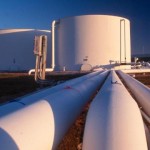Natural gas futures fell on Friday after a government report showed a day earlier that US gas stockpiles fell less than expected last week, spurring profit taking. The energy source however settled the week over 6% higher as weather forecasting models called for more cold weather over the next two weeks before a possible pattern shift in the beginning of February.
On the New York Mercantile Exchange, natural gas for delivery in March fell by 1.28% on Friday to settle at $4.326 per million British thermal units. Prices held in a daily range between $4.293 and $4.385 per mBtu. The power-station fuel rose by 1.32% on Thursday after hitting a 3-1/2-week high and settled the week 6.7% higher, offsetting the previous two five-day periods combined decline of little over 6%.
The energy source retreated on Friday after the Energy Information Administration reported a day earlier that US natural gas stockpiles fell by less than expected in the seven days through January 10th, despite the withdrawal being the largest on record. US gas supplies fell by 287 billion cubic feet, trailing analysts projections for a decrease of 303 billion cubic feet, but was almost double the five-year average decline of 159 bcf.
Total gas held in underground storage hubs equaled 2.530 trillion cubic feet as of January 10th, 20.7% below last year’s 3.189 trillion stored. The deficit to the five-year average widened to a record 14.9% from the preceding week’s 10.1%.
Inventories in the East Region fell by 149 bcf to 1.254 trillion and were 18.9% below the five-year average of 1.546 trillion cubic feet. The West Region received a net draw of 31 bcf to 364 bcf, 11.2% below the average. Stockpiles in the Producing Region slid by 107 billion cubic feet and reached 912 bcf, 10.2% beneath the five-year average of 1.016 trillion cubic feet.
Supportive weather outlook
The energy source however continued to draw support as weather forecasts pointed to below-normal readings across most of the densely-populated US areas throughout the month. NatGasWeather.com reported on Saturday that there are several more reinforcing shots of cold air to push through the Midwest Mid-Atlantic and Northeast over the coming week. The Southeast is also expected to see freezing temperatures. The agency said that the previously predicted cold outbreak around January 26th – 27th has the potential to be the coldest of the recent series. However, latest data shows that thee immensely low temperatures will most likely limit their coverage over the northern states and not push that much into the south, easing some heating demand.
Nevertheless, NatGasWeather.com kept its outlook for below-normal temperatures across most of the US in the week between January 24th and January 31st, coupled with snow and ice. This is expected to heighten natural gas consumption and therefore support prices.
According to AccuWeather.com, the low in New York on January 26th will be 15 degrees Fahrenheit, 12 degrees below usual, while in Chicago readings are expected to bottom at 6 degrees on the same day, well below the average of 18 degrees. In Boston, scales are expected to show a low of 10 degrees Fahrenheit, again 12 below normal, while in Detroit temperatures are expected to sink to 10 degrees, 10 below the average.
However, the website reported that a pattern shift will probably occur in the beginning of February, which will bring mild weather over the central and eastern US for a prolonged period of time. According to the site, it is becoming more likely the West coast will finally see a period of active weather, which will prevent Arctic outbreaks from crossing into the US from Canada, paving the way for higher readings and limiting demand for natural gas.





